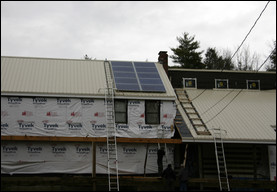 In roof applications, the PV panels are attached to frames that keep them off the surface of the roof to allow for air circulation and prevent overheating. |
In 2006, the federal government began offering homeowners tax incentives to use solar power. Photovoltaic or solar systems produce the same kind of electricity as local power companies, so their energy can be used to power everything from lights and computers to refrigerators and air conditioners. Solar energy is abundant, native, and clean.
All of these benefits, added to the rising cost of fossil fuel, have contributed to a surge in residential use of solar electricity. "We’re seeing more interest now than ever before in photovoltaics," says Noah Kaye, spokesman for the 450-member Solar Energy Industries Association in Washington, D.C. In 2006, 8,500 U.S. homes installed PV systems, up about 75 percent from 2005. The bottom line is predictable utility bills. "It provides you with a hedge against rising electricity prices," Kaye says. Kaye estimates there is currently enough PV capacity installed nationwide to power about 250,000 homes.
How PV Systems Work
The building blocks of PV technology are small solar cells (generally made from crystalline silicon) that produce electricity when they’re hit by sunlight. Since individual cells generate a tiny amount of power, they are usually grouped into solar modules two-to-four feet wide and four-to-six feet long to produce more current. For residential use, an inverter is needed to convert the direct current (DC) generated by the solar cells into alternating current (AC) used by the home’s appliances.
In the past, residential PV systems generally consisted of angled solar panels on the roof or next to a building to catch the sun. In the last few years, however, there’s been an explosion of different types of photovoltaic products. "There’s a lot of different options available to the homeowner," Kaye says, including roof panels, shingles, skylights, windows, and stand-alone units.
Most residential PV systems in the United States are connected to the electric grid and supplement traditional energy sources rather than replacing them. A house may use PV electricity during the day when the sun is shining and power from the grid at night. In most states, homeowners on the grid can channel electricity they don’t use to the power company and receive a credit on their electric bill. PV systems can also be used for homes totally off the grid.
Cost and Savings
A 2-kW system generating about 20 percent of the electricity for an average 2,000-square-foot home connected to the grid will likely cost between $14,000 and $25,000 to install. When all the expenses of the system are averaged out over 30 years, the electricity will cost 30-35 cents per kilowatt-hour. Electric rates vary widely across the country and can range from 20 cents per kWh to 39 cents per kWh. Bob Reedy, director of the Photovoltaics Division at the University of Central Florida’s Solar Energy Center, says the price differential between PV and utility-generated electricity will soon disappear. "We are getting close to parity on-peak nationwide and this is a system that will fix your energy cost for the life of the system," he says. "It is no stretch to imagine on-peak utility energy rates approaching 50 cents/kWh in just a few years."
Benefits
One way to look at a PV system is as a long-term investment in your budget and the environment. The fuel is free and available in unlimited quantities. Once the initial investment is made, that part of your electric bill won’t fluctuate. Properly designed and installed PV systems last about 30 years and require practically no maintenance since there are no moving parts. PV systems can generate power in all types of weather, producing about 25 percent of their maximum output even on overcast days. They don’t create noise or environmentally harmful by-products and they reduce dependence on non-renewable resources like coal, oil, and natural gas.
Drawbacks
In addition to the high start-up expense, another drawback to a PV system is that it needs unobstructed access to the sun most of the day, year-round: No trees or buildings can shade the panels. Most systems also require roof space ranging anywhere from 50 square feet to 1,000 square feet. There are no uniform rules for manufacturing or connecting PV systems, which means you need to hire an expert. "It’s still a bit of a custom installation for most homes," Reedy says. "You can’t go to Wal-Mart or Home Depot and buy one like you do a refrigerator." Many products haven’t been on the market long enough to have a track record and there’s no central clearinghouse with information on quality and performance. So, before you buy a PV system, do as much research as possible.
For the most up-to-date information on solar power as well as state-by-state resources, check out the Solar Action Alliance. Here you’ll be able to access the necessary information regarding solar installations and download resources to help you get started.
Credit: Renovate Your World




























